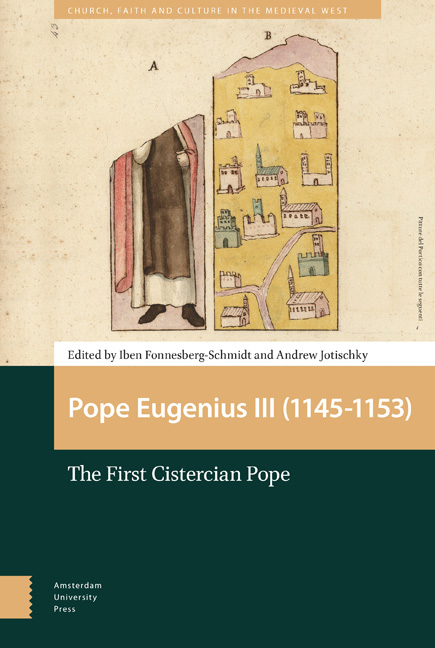Book contents
- Frontmatter
- Contents
- Preface
- Abbreviations
- Maps and Figures
- Introduction
- 1 ‘Justinian’s Laws, not the Lord’s’: Eugenius III and the Learned laws
- 2 Curial Politics and Papal Power : Eugenius III, the Curia, and Contemporary Theological Controversy
- 3 The Cistercians, Eugenius III, and the Disputed York Election
- 4 Eugenius III and the Crusades to the East
- 5 Eugenius III and the Northern Crusade
- 6 The Benefits of Exile
- 7 Eugenius III and France: the Protected Protector
- 8 A Golden Rose and the Deaf Asp that Stoppeth her Ears: Eugenius III and Spain
- 9 Eugenius III and the Roman Commune
- 10 Eugenius III Reclaims the Patrimony of St Peter
- 11 Eugenius III’s Privileges to Cistercian Houses
- 12 Eugenius III at Cîteaux, 1147
- 13 Eugenius III and the Church in the Crusader States
- Index
10 - Eugenius III Reclaims the Patrimony of St Peter
Published online by Cambridge University Press: 22 December 2020
- Frontmatter
- Contents
- Preface
- Abbreviations
- Maps and Figures
- Introduction
- 1 ‘Justinian’s Laws, not the Lord’s’: Eugenius III and the Learned laws
- 2 Curial Politics and Papal Power : Eugenius III, the Curia, and Contemporary Theological Controversy
- 3 The Cistercians, Eugenius III, and the Disputed York Election
- 4 Eugenius III and the Crusades to the East
- 5 Eugenius III and the Northern Crusade
- 6 The Benefits of Exile
- 7 Eugenius III and France: the Protected Protector
- 8 A Golden Rose and the Deaf Asp that Stoppeth her Ears: Eugenius III and Spain
- 9 Eugenius III and the Roman Commune
- 10 Eugenius III Reclaims the Patrimony of St Peter
- 11 Eugenius III’s Privileges to Cistercian Houses
- 12 Eugenius III at Cîteaux, 1147
- 13 Eugenius III and the Church in the Crusader States
- Index
Summary
Abstract
A former vicedominus of the church of Pisa, Eugenius III directed his financial acumen to restore lost papal territory in Tuscia Romana, north of Rome, where he acquired several castra or fortified villages whose inhabitants were willing to become vassals or tenants of the papacy. In the Ciociaria to the south, papal troops took by force the strategic papal fortresses of Fumone and Terracina. In his quest for regalia Eugenius produced a two-volume forerunner of the Liber censuum listing rents, obligations, and payments owed to the pope by right and ownership. At Terracina, a contemporary inscription credits him both for ‘reclaiming the Patrimony of St Peter’ and also for his personal honesty in attempting to limit corruption in the judiciary.
Keywords: vicedominus; Viterbo; Segni; Ciociaria; Rocca de Traversa; inscription; John of Salisbury; Tre Fontane
‘He created one palace at St Peter's and a second at Segni. He recovered Terracina, Sezze, Norma and the stronghold of Fumone which for a long time past had been alienated from the rule of the blessed Peter’.
With this minimalist and somewhat grudging conclusion to his biography, the Vita Eugenii, Boso, former chamberlain or camerarius of the Roman Church and cardinal deacon of SS. Cosma e Damiano, stands accused of seriously underplaying the vigorous recovery and unprecedented territorial expansion of the Patrimonium beati Petri which Eugenius III set in motion during his pontificate. Through a combination of methods born of undoubted financial acumen and relevant administrative experience as vicedominus to the archbishop of Pisa, together with the skilful use and re-working of institutions already established by his predecessors to recoup these losses, Eugenius was instrumental both in masterminding and in organizing the successful initiative directed towards achieving security and stability in papal lands. The novelty of his scheme, which provided the model for recovery over the next half century, was that he and his successors no longer focused solely on securing isolated strong points and consolidating patrimonial frontiers but instead sought to create a dense chequerboard of fortifications from north to south of the Patrimony. An
- Type
- Chapter
- Information
- Pope Eugenius III (1145–1153)The First Cistercian Pope, pp. 271 - 304Publisher: Amsterdam University PressPrint publication year: 2018

